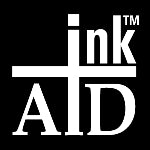What Materials Can You Coat With inkAID Inkjet Coatings?
SUBSTRATES TO USE WITH inkAID INKJET COATINGS
The types of substrates that can be used are nearly limitless. The main factors to note are the substrate’s absorbency, thickness, fragility, and its size and shape. Each of these can affect its performance and impact which inkAID inkjet coating will perform best. Below is a short discussion of the three principal groups of substrate materials, providing very general guidelines.
Important Note: Keep in mind that you’re experimenting as you’re creating your own unique inkjet printable substrate. Start with “small pieces” of material and test, test, test, until you develop your workflow.
Porous/Absorbent Substrates
This group encompasses a wide selection that includes watercolor, printmaking, Japanese rice and other machine made and hand-made specialty papers, as well as non-gessoed canvas, Belgian linen, natural fiber fabrics, and even unusual items like leather or unsealed wood veneer. Any of the inkAID inkjet coatings are good choices. Depending on the absorbency and techniques being used, a minimum of one moderately heavy coating is recommended, but a second, lighter coating may be necessary with certain substrates. In addition, some of these substrates can occasionally benefit from being initially sealed with a clear acrylic medium, like GOLDEN GAC 100, or an acrylic ground such as GOLDEN Gesso.
Non-Porous/Non-Absorbent Substrates
These would include such materials as aluminum, copper, metal foil, stainless steel, and plastics such as Mylar, Lexan, Plexiglas, acetate, tile, and glass. Here you'll need to use inkAID Clear Gloss Type II coating or inkAID White Matte coating. Surfaces must be thoroughly cleaned and free of oils and/or dirt. Metal should be degreased using a good detergent such as “Dawn Dishwashing Detergent” washing with moderately hot water, rinsed well, washed again, and thrn rinsed thoroughly. Dry completely before finally cleaning with 91% isopropyl alcohol or acetone. Only one, moderate to heavy coating, is required to give the best results. Apply the coating to your substrate on a level surface, raised off of the table, with a piece of plastic surrounding the entire piece. The coating is “self leveling” so apply enough until it just begins to spill over the edges of your substrate. With non-porous substrates you can’t apply “too much” coating but you can apply “not enough”.
Acrylic Skins and Painted Surfaces
Almost any surface painted or created with acrylic paints, gels, pastes, or mediums can be printed on by first coating them with one of the inkAID inkjet coatings. This includes skins or free films of acrylic material that can then be coated, printed, then layered, collaged or further developed for incorporation in other pieces. For a clear coating, either the inkAID Clear Gloss or inkAID Clear Gloss Type II can be used. inkAID White Matte coating is useful when wanting an opaque, white layer to print on top of. Only one, moderate to heavy coating, is usually required to give the best results. We do not recommend apply multiple light coating layers of inkAID White Matte coating.
